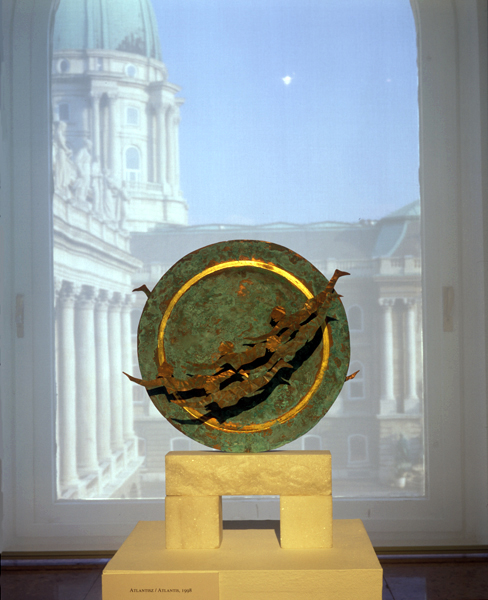The name of Gyula Gulyás became known through his geometrical statues from the decade of 1970 in the style of Minimal and Conceptual Art. In the 1980's, he surprised his audience with his amusing plaster portraits, which shed light on the sculptor's other talent: his brilliant ability to depict different types of characters. The bust of Marilyn Monroe became the starting point for a larger series. The main character of the series is the legendary actress. Characteristics of Pop Art probably came with the choice of topic; however, traces of this style can already be discovered in the portraits. Undoubtedly, these works are quite eclectic. He combines figurative elements with geometrical sections, layered surfaces with entirely smooth, even painting, and incorporates photo cut-outs as well. The technique of Gulyás started to turn in the direction of a two-dimensional style. Though his works have various objects embedded in the surface so that the work becomes dimensional, these works are understood as paintings rather than sculptures.
The artist spent some time in Rome on a scholarship in 1994. It was there that he began to produce drawings and graphic art, which introduced yet another angle of his expressive abilities. The graphic drawings are independent works, not sculpture sketches. The themes and motifs are the same as in the sculptures, but are not their precedents. He exhibited a few pieces from his new series in the Fészek Gallery in 1994. The spirit of Rome, antiquity, and the Mediterranean has left their permanent mark and inspire him to produce new works.
The clear, dominant colours used in the Marilyn Monroe series were replaced by brick red and deep blue, as well as the black and white inspired by Rome. His palette became simpler, the use of colours significantly more held back.
The plaster and wood-fibre used previously in his sculptures have become stone, red copper and bronze, the classical sculpting elements representing those works that last through the ages.
The human figure, appearing several times, can be traced to an Etruscan statuette; it becomes a pattern merging with the geometrical plane. In the sculptures entitled The Great Jump, Metronome, and Contacts, the bronze human figure always has a different correlation to the carved stone shape protruding from or sinking into the surface. He plays with one idea, going through all the variations, so it's no surprise if his new works are in a series.
The figures in the statues entitled Golden Age and Tiberius’ Goldfish are no longer bodies, but forms cut out from sheet metal. Hence, they are a lighter, more expressive representation of the saying, "Ars longa, vita brevis".

